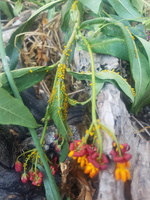Enjoy being online again!
Welcome to the community of good people who base their values on evidence and appreciate civil discourse - the social network you will enjoy.Create your free account
4 comments
Feel free to reply to any comment by clicking the "Reply" button.Tropical Milkweed (Asclepias curassavica) is a no-no in temperate areas. It is best to keep with native species to your region. The reasons are
A. Tropical does not harden off in midsummer in preparation. It keeps growing continually til frost.
Any Monarchs still in the region are liable to lay eggs too late in the season on this nonnative.
B. This plant is a suspected host to OE, an obnoxious protozoa that causes gross deformity in adults.
C. Plants grown outside their realms ("annuals" ) generally suck as host plants or nectar sources anyway and are generally ignored for the most part. Tropical Milkweed likes it HOT and HUMID.
I find it performs poorly in the MW, except for on hot summers
Yeah, haven't seen any monarchs. The cuttings came from my sister in Southern California. She has a pretty impressive operation and has raised and released hundreds of monarchs and swallowtails. I call her the butterfly Daenerys.
@misternatureboy
This year Monarchs and other butterflies have been almost numerous compared to last several seasons. The Milkweed I use most are Common (Asclepias syriaca) and Swamp (Asclepias incarnata) Milkweeds.
These are native and are preferred over Tropical by the Monarch. I live in an ecoconscious county, and everyone grows Milkweed.
The city of Madison includes Tropical Milkweed in its annual desplays, but this is wrong. Monarchs still prefer the hardier natives.
are those aphids on it?
Yup, hence the need for pruning.
Are the yellow rice like things aphids?
Fat and juicy ones!
@misternatureboy good for the lady birds.
@FrayedBear Had to prune 'cause no ladybugs were eating them and they were taking over.
There are so many different kinds of milkweed. Truly amazing! Nice photo.
Enjoy being online again!
Welcome to the community of good people who base their values on evidence and appreciate civil discourse - the social network you will enjoy.Create your free account
Share this post
Categories
Agnostic does not evaluate or guarantee the accuracy of any content. Read full disclaimer.








